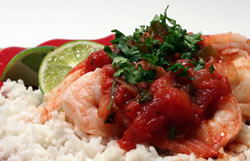The frozen food section of the grocery store contains foods ranging from pizza and snack foods to traditional meat-loaf-and-mashed-potato dinners to meals targeted at people with health concerns including weight loss, heart health and vegetarian eating.
Despite all the advertisements promoting weight loss-oriented meals, many consumers are confused about whether "diet" dinners really offer the help they need.
Research clearly shows that today's exploding portion sizes are making weight control more difficult for many people. One advantage frozen meals offer is that they are portion-controlled, preventing overeating if you only eat one dinner.
Even if you don't plan to continue eating frozen meals on a permanent basis, you might use them long enough to help you readjust your expectations of what constitutes a normal portion size.
Those who use frozen diet meals often argue that these are the easiest way for a busy person to get a healthful, low-calorie meal.
If the alternatives are eating high-fat choices from fast-food restaurants or cafeterias, or simply grazing on a variety of snack foods instead of bothering to fix a meal "from scratch," these frozen meals look pretty good.
However, in the long run, this can promote an all-or-nothing mentality: When the frozen meals are not available, people go back to their old habits because they haven't learned how to make other healthful choices that fit their lifestyle. Some people look for meals as low in fat and calories as possible.
Products that flaunt content "less than 300 calories" may actually be too low in calories for many people. If calories are spread fairly evenly through the day, as is usually recommended, then such a meal was designed for someone who eats only 1,000 calories a day. Diets containing 1,000 to 1,200 calories are really too low to meet the metabolic needs of most adults.
If calorie intake is limited to 1,000 to 1,200 calories, metabolic rate may slow down, making weight control more difficult.
Metabolism is the burning of energy (calories) for functions needed to stay alive, such as digestion, growth, blood circulation and healing.
Many people who aim for such a low calorie intake end up so hungry or low on energy that they start grabbing snacks high in calories and lacking in nutrients after only a few hours.
Not only are these "under 300 calorie" meals too low in calories to satisfy you for a few hours, they also tend to provide only a small fraction of the vegetables, fruits and grains you need.
Current recommendations to promote overall health call for a total of five to eleven servings of vegetables and fruits a day. Even when calories are reduced to create weight loss, two-and-a-half to three cups a day (5 or more servings) of these foods are recommended. Most frozen meals supply a very small portion of fruits and vegetables.
Sodium content is another concern. Frozen meals that aren't identified as reduced-sodium or heart-healthy often contain from 700 to 1,800 milligrams (mg) of sodium. That makes it challenging for people to stay below the daily maximum of 2,300 mg recommended for the general population. Such levels make it almost impossible for people who are more "salt sensitive" (those with high blood pressure, African-Americans and middle-aged and older adults) to stay below their recommended limit of 1,500 mg per day.
What is the solution? First, use the Nutrition Facts label on a frozen dinner or entree to help you choose one that is low in fat and sodium, and use the product as a base for a quick, nutritious meal.
Round out the meal with extra fruit or vegetables and perhaps a whole-grain roll or bread. But don't fall into the same trap as people who only know how to diet by following pre-planned menus. If you decide to use them, frozen meals should be just one of the many ways that you create balanced meals and appropriate portions.
0
AICR







